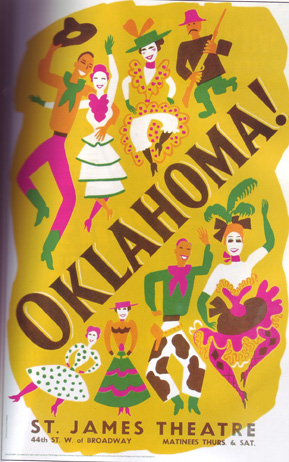 |
The Right Musical at the Right Time
By
FRANK BEHRENS
ART TIMES May 2008
Consider. “Oklahoma!”
opened in March 1943. “Remember Pearl Harbor” was still a rallying cry
and young men were dying for a cause that was clear and an enemy that
was identifiable. Hollywood was churning out propaganda films in which
Robert Taylor was gunning down troops of Japanese and every regiment had
an even distribution of ethnic types. While Claudette Colbert, Greer Garson
and Irene Dunne were showing us “what we were fighting for,” Rodgers and
Hammerstein, consciously or not, were creating a myth—just at the
time it was needed.
The plot? Will the nice
Curly or the evil Judd take Laurie to the picnic? (No joke, that’s all
it boils down to.) Since that is not exactly what is needed to fill up
over two hours on stage, the required second plot involves Ado Annie and
Will and the sort of life they will lead. Not very promising.
However, using the plot
of “Green Grow the Lilacs” (a flop), the team gave the audience (again,
above and beyond the score and lyrics), believable people living in a
territory that is not yet a state, going through a small crisis that will
or will not lead to marriage and babies, and somehow tying together the
political background, the social problems (can the farmer and the cowboy
ever be friends?) and the personal relationships—all into a unified
whole that plays more like a myth than a typical musical.
As I said in at least
two past essays, the show opens up with a hymn to the crops and to a beautiful
morning. It ends with a salute to the new state and returns to “Oh, what
a beautiful morning.” (So many people still believe the show ends with
the title song!) This is just what the 1943 audiences needed: reassurance
that there will indeed be many more beautiful mornings, “when the lights
go on again all over the world,” as singer Vera Lynn was at the same time
promising the British soldiers.
“Carousel” opened (symbolically)
in April 1945, a month closely connected with the blossoming of springtime.
If the audience was surprised to find “Oklahoma!” beginning with an off-stage
solo instead of the usual chorus, how much more was the “Carousel” audience
surprised to see the first act end with the death of the leading male.
Yes, the war was just
about over and the monumental task of getting Europe back on its feet
was yet to begin. What was to be LEARNED from the slaughter that was the
result of not only a single madman but of all the “normal” people who
believed him and allowed him to “move ahead” with his plans to dominate
a planet? Again, the show tries to answer the questions of the times in
terms of individuals.
Billy is allowed to return
to make up for what he did to the daughter he died too early to know.
Although a ghost, he is still human and fails. The show ends, not with
a beautiful morning, but with advice about how to walk through a storm.
Never walking alone and having hope in your heart is the answer Hammerstein
gives us.
Of course, that is semantic
nonsense. But in 1945 it was exactly what audiences wanted to hear, because
it SOUNDED good and therefore it was good. (Years later, “Climb every
mountain” tried to deliver the same message but sounded simply pretentious.
You see, once having succeeded with that sort of ending, Rodgers and Hammerstein
were stuck with it.)
A year and a month later,
“Annie Get Your Gun” opened—again, just at the right time. The men
were back on the job and women were back on the range—the kitchen
range, that is. Factory owners could not help but notice how much better
on the whole the women worked on the assembly lines than did the men.
But in 1946, the girl that one married had to be as soft and as pink as
a nursery, not muscular and grease-stained like Rosie the Riveter.
However, Annie still
outshoots the male competitors, showing once again that a woman can do
anything you (males) can do. Just the right thought at the right time,
although many of the males in the audience took it all as a joke. After
all, how many Annies are there in real life? (More than men care to admit,
as in the current bid for the presidency.)
The question of the times
influencing the musical and the musical influencing the times certainly
deserves closer and deeper and more extensive study than just this superficial
look. Perhaps future essays in this journal will be devoted to just that
subject. Yes, “Show Boat” is certainly a candidate. Do my readers have
any other suggestions?
